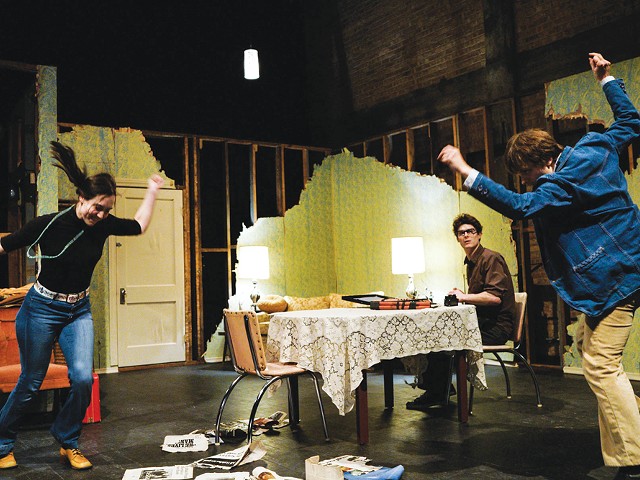Of all the artistic children of Detroit, Ray Johnson (1927-1995) is among the greatest and most influential, yet he might also be the least understood. His work was often given away for free, through the mail — generally without the recipient asking for it. His graphic, ephemeral, and nuanced Xeroxes would often be drawn upon with a marker. They were frequently obscene, regularly hilarious, and always-playful works that mixed his own stylized cartoon iconography with found images and objects, including images of celebrities and the names of art world insiders.
Johnson grew up in a working-class neighborhood and attended Cass Tech, where he enrolled in an advertising art program. His dad worked the line at the Ford plant. Johnson studied art as early as junior high school and spent a summer in a drawing program at Ox-Bow in Saugatuck. Leaving Detroit in the summer of 1945, he attended the fascinating experimental program at Black Mountain in Asheville, N.C., where he worked with artist-teachers like Josef Albers, Lyonel Feininger, and Robert Motherwell. He even collaborated with visiting musician John Cage on a performance piece and befriended Buckminister Fuller.
The experience of being mugged at knife point (on the same day in 1968 when his friend Andy Warhol was shot by Valerie Solanas) prompted a relocation to the safe remove of Glen Cove, Long Island, where Johnson remained until his death. He committed suicide by drowning off the coast of Sag Harbour on Friday, Jan. 13, 1995, in a deliberate and staged act that most consider his "last performance."
In his lifetime, Johnson was frequently referred to as the "best known unknown artist" and was an early practitioner of conceptual art, a founder of the mail art movement, and a prolific and very hard to pin down practitioner of Pop Art. The critically acclaimed 2002 documentary How to Draw a Bunny did a bit to realign Johnson's place in the art world — a world he consistently mocked, right to its face, with his collages and drawings.
On display now at CCS, Ray Johnson: The Bob Boxes is the largest show of Ray Johnson's work in his hometown since an exhibition at Gertrude Kasle in 1975. "Innumerable people here were connected to Ray Johnson and have been sharing stories in the gallery," Jonathan Rajewski, the CCS gallery's coordinator and curator of the exhibition, says via email. "Ray continued to visit Detroit after leaving for Black Mountain College, and it seems clear in the Nick Maravell films on display in the exhibition — the countless storied references to Detroit; people, places — that Detroit was something he thought about regularly."
The expertly laid-out exhibition includes the contents of boxes that Johnson crammed with found objects and artwork, which he gave to the New York City-based artist Bob Warner during their eight-year correspondence.
Warner had contacted Johnson in 1988 by sending him a collage on paper. Johnson was curious where to get more of the same paper. After Warner sent along his remaining paper stash, the two became fast friends, talking on the phone daily while mailing hundreds of works back and forth to each other. On the phone from the South Street Seaport Museum where Warner today works as the master letterpress printer, he is warm and eager to discuss his friend's work.
"Ray would always direct me," Warner says. "I was kept busy with the things Ray had in mind. He would ask me to go to galleries on my lunch hour and ask where his work was, what was on the left and what was on the right, and what were they selling for. Once he sent me a newspaper with the drawing of a sock on it that has text which reads, 'My sock please return to [artist] Bob Rauschenberg.' He asked me to send it over to Rauschenberg, but I liked it so much, I didn't. I kept it, and never told him."
Warner worked closely with Rajewski to lay out the contents of the boxes. This is the fifth time the "Bob boxes" have been exhibited, and the first where pedestals were used, which means that they can't be called "Tables of Content" (get it?) as they have been before, but it makes them float in place as obsessive pack-rat artworks in and of themselves.
The walls teem with his playful and largely black-and-white works, while these other colorful bits bob in your line of vision at the heart of the space. "This is my archive, the 'Bob Box' archive, and it's stored at the estate," Warner says. There's book spines, ties, elastic underwear waist bands, belts, art world ephemera, drawn-on coffee cups, twine, can lids, inflatable birthday cakes, wigs, water bottles, tennis balls, baby shoes, cans of toy food, paint stirrers, and some stuff you're not sure what it is. The decaying cardboard box that holds coiled belts is marked "snakes" on its side, in red felt tip marker.
"When the estate went through his house after he died, there was one package left with my name on it and no address so they gave it to me. Ray Johnson had written inside a book these words: 'There are some Tibetan monks who choose the day that they die.' And I realized that his death was his choosing; he didn't seem to be in any pain at the time. He didn't seem ill; it was just his choice. It was an event that he chose. Ray always had a wicked sense of humor, and that seems the last prank he played on the world. Later I learned there was an envelope in his safety deposit box with the word 'will' written on it. But there was nothing in it."
The show also includes artwork, objects and materials that reference Ray Johnson's childhood in the Detroit area. CCS' Rajewski says he wanted to include material that provides direct links to Johnson's life in Detroit.
"I took a trip to New York City in July to visit the Ray Johnson Estate, where Maria Ilario and Frances Beatty had brought out notebooks, sketches, homework, and yearbooks from his Cass Tech days, collages from later in life that reference Detroit, much of which had not been previously exhibited."
Ray Johnson: The Bob Boxes runs until Oct. 8 at the Valade Family Gallery inside the first floor of the A. Alfred Taubman Center for Design Education; Gallery hours are noon-5 p.m., Wednesday-Saturday; 460 W. Baltimore, Detroit; collegeforcreativestudies.edu; free.






